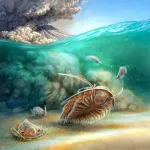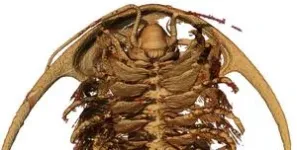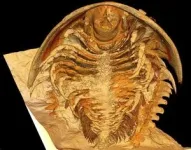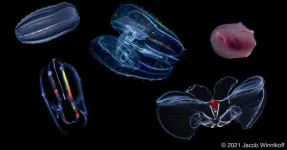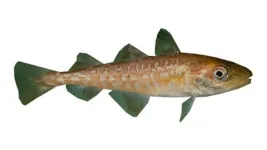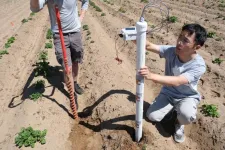(Press-News.org)
Researchers have described some of the best-preserved three-dimensional trilobite fossils ever discovered. The fossils, which are more than 500 million years old, were collected in the High Atlas of Morocco and are being referred to by scientists as “Pompeii” trilobites due to their remarkable preservation in ash.
The trilobites, from the Cambrian period, have been the subject of research by an international team of scientists, led by Prof Abderrazak El Albani, a geologist based at University of Poitiers and originally from Morocco. The team included Dr Greg Edgecombe, a palaeontologist at the Natural History Museum.
Dr Greg Edgecombe comments: “I’ve been studying trilobites for nearly 40 years, but I never felt like I was looking at live animals as much as I have with these ones. I’ve seen a lot of soft anatomy of trilobites, but it’s the 3D preservation here that is truly astounding.
“An unexpected outcome of our work is discovering that volcanic ash in shallow marine settings could be a bonanza for exceptional fossil preservation.”
Due to their hard, calcified exoskeleton often being well-preserved in the fossil record, trilobites are some of the best studied fossil marine animals. Over 20,000 species have been described by palaeontologists over the past two centuries.
However, until now, comprehensive scientific understanding of this phenomenally diverse group has been limited by the relative scarcity of soft tissue preservation. Owing to the fact the Moroccan trilobites were encased in hot ash in sea water, their bodies fossilised very quickly as the ash transformed to rock – meeting a similar end to the inhabitants of Pompeii following the eruption of Mount Vesuvius.
The ash moulds preserved each segment of their bodies, their legs and even the hair-like structures that ran along the appendages. The trilobites’ digestive tract was also preserved after it filled with ash. Even small “lamp shells” attached to the trilobites’ exoskeleton remained attached by fleshy stalks as they were in life.
Lead author, Prof Abderrazak El Albani, comments: “As a scientist who has worked on fossils from different ages and locations, discovering fossils in such a remarkable state of preservation within a volcanic setting was a profoundly exhilarating experience for me.
“I think pyroclastic deposits should become new targets for study, given their exceptional potential for trapping and preserving biological remains, including delicate soft tissues.
“These findings are anticipated to lead to significant discoveries about the evolution of life on our planet Earth.”
Using CT scanning and computer modelling of virtual X-ray slices, the researchers discovered that appendages found at the edge of the mouth had curved spoon-like bases but were so small they had gone undetected in less perfectly preserved fossils. In fact, it had previously been thought that trilobites had three pairs of head appendages behind their long antennae but both Moroccan species in this study showed that there were four pairs.
A fleshy lobe covering the mouth, called a labrum, was documented for the first time in trilobites.
Co-author Harry Berks, from the University of Bristol, added: “The results revealed in exquisite detail a clustering of specialised leg pairs around the mouth, giving us a clearer picture of how trilobites fed. The head and body appendages were found to have an inward-facing battery of dense spines, like those of today’s horseshoe crabs.”
The paper, Rapid volcanic ash entombment reveals the 3D anatomy of Cambrian trilobites, will be published online in the journal, Science, on Thursday 27 June, 19:00 BST, and in print on Friday 28 June. The paper can be accessed from that time here.
Notes to editors
Assets
Images are available here.
Press contact
Natural History Museum Press Office
Tel: +44 (0)20 7942 5654 / 07799690151
Email: press@nhm.ac.uk
About The Natural History Museum
The Natural History Museum is a world-leading science centre and one of the most visited attractions in the UK. A global source of curiosity, inspiration and joy.
Our vision is to build a future in which both people and the planet thrive.
We aim to be a catalyst for change, engaging advocates for the planet in everything that we do. Our 350 scientists are finding solutions to the planetary emergency in all aspects of life.
Visit, join and support the Natural History Museum today. Protecting the planet. It's in our nature.
END
CAMBRIDGE, MA — Researchers from MIT and the University of Michigan have discovered a new way to drive chemical reactions that could generate a wide variety of compounds with desirable pharmaceutical properties.
These compounds, known as azetidines, are characterized by four-membered rings that include nitrogen. Azetidines have traditionally been much more difficult to synthesize than five-membered nitrogen-containing rings, which are found in many FDA-approved drugs.
The reaction that the researchers used to create azetidines is driven by a photocatalyst that excites the molecules from their ground energy state. Using computational models that they developed, the researchers ...
Plants are powerhouses of molecular manufacturing. Over the eons, they have evolved to produce a plethora of small molecules — some are beneficial and valuable to humans, others can be deadly. For years, a good way for scientists looking for new medicines to distinguish beneficial plant-derived molecules from harmful ones has been through a scientific sniff test — dab a bit of the molecule at one end of a petri dish and drop tiny nematode worms (C. elegans) at the other, then wait to see if the chemically sensitive worms move toward or away from the compound in question, a process known as chemotaxis.
This “artisanal” ...
The bottom of the ocean is not hospitable: there is no light; the temperature is freezing cold; and the pressure of all the water above will literally crush you. The animals that live at this depth have developed biophysical adaptations that allow them to survive in these harsh conditions. What are these adaptations and how did they develop?
University of California San Diego Assistant Professor of Chemistry and Biochemistry Itay Budin teamed up with researchers from around the country to study the cell membranes of ctenophores (“comb jellies”) and found they had unique lipid structures that allow them to live under intense pressure. Their work appears in Science.
Adapting ...
EMBARGOED UNTIL 27-Jun-2024 14:00 ET
Drug development is typically slow: the pipeline from basic research discoveries that provide the basis for a new drug to clinical trials to production of a widely available medicine can take decades. But decades can feel impossibly far off to someone who currently has a fatal disease. Broad Institute Senior Group Leader Sonia Vallabh is acutely aware of that race against time, because the topic of her research is a neurodegenerative and ultimately fatal disease–fatal familial insomnia, a type of prion disease–that she will almost certainly develop as she ages. Vallabh and her husband, Eric Minikel, switched careers ...
For a broad range of industries, separating gases is an important part of both process and product—from separating nitrogen and oxygen from air for medical purposes to separating carbon dioxide from other gases in the process of carbon capture or removing impurities from natural gas.
Separating gases, however, can be both energy-intensive and expensive. “For example, when separating oxygen and nitrogen, you need to cool the air to very low temperatures until they liquefy. Then, by slowly increasing the temperature, the gases will evaporate at different points, allowing one to become a gas again and separate out,” explains Wei Zhang, a University of Colorado Boulder professor ...
During recent periods of unusually warm water in the Gulf of Alaska, young Pacific cod in near shore safe havens where they typically spend their adolescence did not experience the protective effects those areas typically provide, a new Oregon State University study found.
Instead, during marine heat waves in 2014-16 and 2019, young cod in these near shore “nurseries” around Kodiak Island in Alaska experienced significant changes in their abundance, growth rates and diet, with researchers estimating that only the largest 15-25% of the island’s cod population survived the summer. Even after the high temperatures subsided, the ...
Bird flu, or H5N1 virus, in unpasteurized milk is stable on metal and rubber components of commercial milking equipment for at least one hour, increasing its potential to infect people and other animals, report researchers from the University of Pittsburgh School of Medicine and Emory University in Emerging Infectious Diseases.
The study underscores the heightened risk of bird flu exposure for dairy farm workers and signals the need for wider adoption of personal protective equipment, including face shields, masks and eye protection.
“Dairy cows have to be milked even if they are sick, and it has not been clear for how long the virus contained in residual milk from the ...
MADISON — University of Wisconsin–Madison engineers have developed low-cost sensors that allow for real-time, continuous monitoring of nitrate in soil types that are common in Wisconsin. These printed electrochemical sensors could enable farmers to make better informed nutrient management decisions and reap economic benefits.
“Our sensors could give farmers a greater understanding of the nutrient profile of their soil and how much nitrate is available for the plants, helping them to make more precise decisions on how much fertilizer they really need,” says Joseph Andrews, an assistant professor of mechanical ...
Growing up in neighborhoods with more educational and socioeconomic opportunities has a positive impact on infants’ brain activity, according to new research from Boston Medical Center (BMC). The study, published in The Journal of Developmental & Behavioral Pediatrics, suggests that enhancing neighborhood opportunities, particularly in education, can be a promising approach to promoting early childhood development.
A team of early childhood researchers examined how neighborhood opportunity – the socioeconomic, educational, health, and ...
WEST LAFAYETTE, Ind. — Across the Midwest during the warmer months, studying the sky for signs of storms and tornadoes becomes one of the most popular pastimes.
Dan Chavas, an associate professor in the Department of Earth, Atmospheric, and Planetary Sciences at Purdue University’s College of Science, takes it further: All day every day, he studies what makes tornadoes tick. Working at the intersection of climate science and meteorology, he looks at the big picture of what causes severe storms and tornadoes — and what dictates where ...
